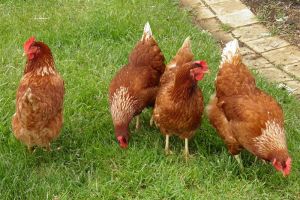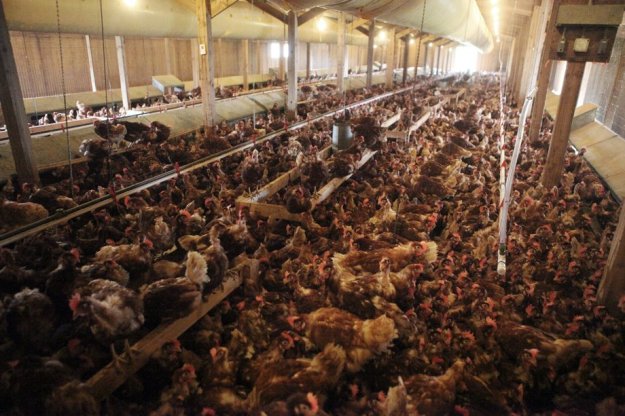Recently, McDonald’s has pledged to phase out the use of caged eggs within three years. Subway Australia followed swiftly. The company wants to switch to cage-free eggs within 12-18 months. Last year, Woolworths announced that it will phase out all caged eggs from sale and the use of caged eggs in the ingredients of its own brand products by December 2018. Coles brand eggs are already cage-free. They are either barn-laid or free range.
But does it make a difference? A difference to the hens? A difference to the egg consumer?
Let’s first examine what the terms “cage”, “barn” and “free range” mean.
The Model Code of Practice for the Welfare of Animals. Domestic Poultry 4th Edition, endorsed by the Primary Industries Ministerial Council in May 2002, provides these definitions:
Birds in cage systems are continuously housed in cages within a shed.
Birds in barn systems are free to roam within a shed which may have more than one level. The floor may be based on litter and/or other material such as slats or wire mesh.
Birds in free-range systems are housed in sheds and have access to an outdoor range. (p. 2)
The Model Code also provides minimum standards. The minimum stocking density in a caged system is 550 cm2 per hen in cages with three or more birds with a weight of up to 2.4 kg, or 600 cm2 per hen in cages with three or more birds that weigh more than 2.4 kg (p. 25). This is approximately the size of an A4 sheet of paper.
For non-caged systems, the indoor minimum stocking density is 30 kg live weight per square metre (p. 27). Assuming the average hen weighs 2.4 kg, this allows 12.5 birds per square metre. The space covered by feeding and watering equipment is included in these measurements.
Indoors, the maximum acceptable live weight density for free-range birds is the same as that for non-caged systems (see above). Outdoors, a maximum of 1,500 hens per hectare is considered adequate by the Model Code. However, a higher density is acceptable in certain circumstances (p. 28). The consumer advocacy group Choice claims that almost a third of eggs sold with a free range label have a stocking density more than 13 times greater.
An A4 size space per bird in barns does not allow for natural behaviours, such as running, dust bathing, perching or stretching wings. In free-range systems, which indoors allow a similarly crowded space as barn systems, will hens be able to make their way to the outdoor area?
Choice writes on its website that Australia has no official national standard for free range eggs, and the label on the egg carton can have any number of meanings depending on the producer.
Without an official standard for free range products, consumers are at real risk of being misled by businesses wanting to cash in on the premium that a free range product attracts.
Similarly, Animals Australia observes that there are no consistent or legally enforceable definitions for egg production systems in Australia. The animal advocacy organisation provides a handy chart and flyer with details of the birds’ living conditions according to various claims on egg carton labels.
Cage, barn or free-range – does it make a difference to the birds?
Common to all types of commercial egg production is that male chicks are killed at birth, and that hens are sent to slaughter from the age of 18 months, although their natural lifespan is around 10 years. That’s similar to the lifespan of a large dog.
No, the type of commercial egg production does not make a difference to the approximately 12 million male chicks in Australia that are killed each year on the first day of their lives.
No, it does not make a difference to the layer hens who have their lives cut short.
Whether a hen lives in a cramped cage with a small number of other hens or in a barn as crowded as that in the photo below, does it make a difference to a hen’s quality of life?
Will she, surrounded by thousands of other hens, feel as safe as in a cage that is also crowded, but has not as many competitors for space, food and drink? I’m not sure what the answer to these questions is.
There are also claims that a caged system is advantageous to the health of hens and that of the egg consumer.
Dr Peter Scott, consultant veterinarian to the intensive poultry industry and senior research fellow at Melbourne University, warns that in free-range systems
… old bacterial diseases are re-emerging, internal and external parasites and unfortunately in this country we don’t have the tools to control it.
Brian Ahmed, a farmer and president of the Victorian Farmers Federation Egg Group, claims that
by moving to a cage-controlled system from free-range egg farming, we reduced the rates of disease in the birds, we better protected them from predators and parasites, they produce cleaner and more affordable eggs, and we’ve reduced their mortality rate to 1%.
(And by the way, I commend Mr Ahmed for inviting journalists to visit his farm and take photos)
Cage, barn or free-range – does it make a difference to the egg consumer?
Yes, I think it does. And I’m not only referring to the increased price of free-range eggs. Considering the living conditions of layer hens and being prepared to pay more for eggs that are believed to be produced in more humane conditions shows compassion. And compassion for the plight of our fellow non-human animals asserts our humanity. Compassion does make a difference to our world.
It is impractical for most egg consumers to investigate in person the hens’ living arrangements and they take their information from the egg carton label. But carton labels do not provide an accurate picture of the hens’ living conditions, and consumers are fooled.
Conversely, much information about the dreadful conditions forced on hens in commercial farming is publicly and freely available. Once we become aware of this information, the only compassionate choice is to give up commercially produced eggs. And yes, we can live well without eggs.

